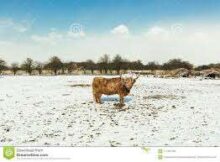When temperatures plummet, cattle may need additional shelter and feed resources for optimum health
MANHATTAN, Kan. — After working outside on a cold winter’s day, cattle producers know there is nothing quite like coming inside to a warm house and filling their stomachs with those favorite comfort foods.
And though cattle are naturally equipped to manage cold temperatures, like humans they need some extra care to make those frigid winter days a little easier, according to the experts at the Kansas State University Beef Cattle Institute.
On a recent Cattle Chat podcast, BCI veterinarians Brad White, Bob Larson and Phillip Lancaster discussed ways for ranchers to help their herds from experiencing cold stress.
“Cattle handle cold weather reasonably well as they have a thermoneutral zone (the range of temperatures where they don’t expend extra calories) that goes as low as 20 degrees Fahrenheit,” Larson said.
Nutritional Maintenance
“However, once that temperature drops 10 more degrees with a wind chill, their nutritional maintenance requirement will double,” said Lancaster, who also serves as the BCI nutritionist.
He said that on cold winter days, cattle ranchers need to add feeds that increase the energy in the ration.
“Instead of using a high starch energy source like corn, I recommend producers supplement with feeds such as distiller’s grains, soybean hulls or wheat midds to provide energy but is also a highly digestible fiber,” Lancaster said.
Larson cautioned that thin cows may need extra feed and care in cold weather to avoid additional health challenges.
“A thin cow is much more sensitive and expends energy more quickly than her fleshier herd mates,” Larson said. He suggested that those cattle may need to be sorted and managed differently from the rest of the herd.
Another aspect of meeting the nutritional needs is providing access to clean water, said the veterinarians.
“In cold weather cattle don’t drink water often, so it is important that the water access is open to them not only at feeding time, but other times of the day as well,” White said.
Enhancing the Environment
Along with meeting the increased nutritional demands, the veterinarians stressed the importance of providing cattle adequate housing to keep them dry.
Larson said that while cattle will often find breaks in the hills that keep them from the wind, it is important to provide additional shelter and bedding to keep them protected and warm.
One strategy is to roll out the hay on the ground in the pasture to provide forage, but also give the cattle natural bedding outdoors.
“Understand that you will be wasting some hay by feeding it on the ground, but you will likely save the overall energy costs for the herd because the bedding will allow them to stay warm,” Larson said.
White agreed: “Cold temperatures are short term and sometimes require immediate solutions. It is not a winter long feeding decision; rather, it is this week’s feeding plan.”
To hear more of their discussion, tune in to the BCI Cattle Chat podcast online.
FOR PRINT PUBLICATIONS: Links used in this story
BCI Cattle Chat podcast, https://ksubci.org/2021/02/19/synchronization-programs-in-heifers-cold-stress-management-sustainability-in-grasslands/
K State Research and Extension is a short name for the Kansas State University Agricultural Experiment Station and Cooperative Extension Service, a program designed to generate and distribute useful knowledge for the well being of Kansans. Supported by county, state, federal and private funds, the program has county extension offices, experiment fields, area extension offices and regional research centers statewide. Its headquarters is on the K State campus in Manhattan. For more information, visit www.ksre.ksu.edu. K-State Research and Extension is an equal opportunity provider and employer.
Story by:
Lisa Moser
785-532-2010
lmoser@ksu.edu
More information:
Phillip Lancaster
785-532-6323
palancaster@vet.ksu.edu
Bob Larson
785-532-4257
rlarson@vet.ksu.edu
Brad White
785-532-4243
bwhite@vet.ksu.edu





